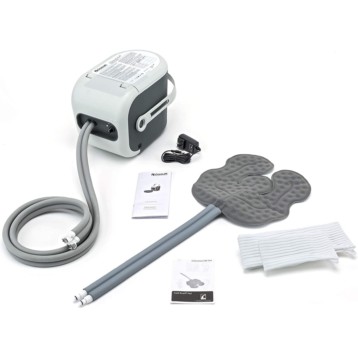Designed to help people with severe motor disabilities, the new chair mounts a laser on its front that constantly scans the surroundings to update an image presented to the user on a display that sits in front of their eyes. Blue spots flash in sequence over possible destinations in the image; when it flashes over the point where the user is looking, their brain activity fluctuates. A skullcap containing 16 electrodes detects these millisecond-long fluctuations. The onboard computer compares the sequence of flashes with the user’s brain activity to determine which blue spot prompted the increased brain activity and interprets that as a directive to move to that location.
The laser scans also map out obstacles between the wheelchair and its destination, continually updating this information in case any of those obstacles change. Sensors on the wheels also count the number of rotations completed to track the distance moved and compare that to its knowledge of the selected destination as gathered by the laser to further help the guidance process.
Because the thought processes of each person differ slightly, the wheelchair must first be trained to detect the responses of each individual user. Such training is both quick and simple; it involves staring at a series of test images in a preset order so the processor knows how your brain activity actually spikes when looking at specific images. Five healthy test subjects were able to confidently direct the wheelchair both through open spaces and around obstacles within the first 45 minutes of sitting down in the chair.
One drawback of this system is that it can only process two thought commands per minute which sounds quite limiting. However, since it moves autonomously once a destination location is chosen, the chair doesn’t require many commands to be processed simultaneously. A larger problem is that the chair can only be used for about two hours before the gel holding the electrodes to the user’s scalp dries up. An alternate attachment method is necessary before it could be used by wheelchair-bound people as a normal mode of transportation.
TFOT has previously reported on other assistive technologies including the Honda Stride Management Assist and Bodyweight Support Assist systems that help people walk and crouch more easily, the Hybrid Assistive Limb (HAL) robot suit designed to help paralyzed people to walk again, a personalized user interface that adopts itself to the specific visual and motor abilities of its users, the potential for mind-controlled bionic limbs as a replacement for current prosthetic devices, a system designed to control mouse movement using eye movements, and the COGAIN gaming system that allows users to control gaming functions with eye movements.
Read more about the wheelchair and view several videos at a page hosted by one of the researchers or read a paper (PDF) published in a recent issue of IEEE Transaction on Robotics describing the invention in detail.










